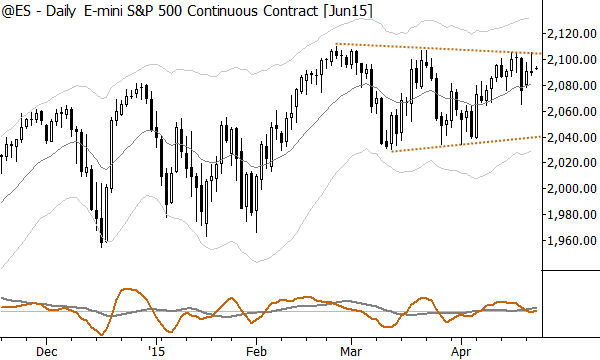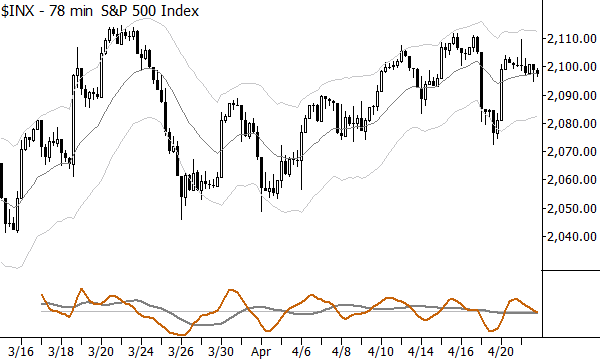An easy way to avoid some losses
I can get right to the punchline, and make this a very short blog post: don't trade when the market you trade is in consolidation; more specifically, do not trade when the timeframe you trade is in consolidation. The "small losses" that accumulate when we trade a choppy market can have some very negative effects on our bottom line. If you want a longer blog post, stick with me, and let's look at why this is so, what we can do about it, and I'll share a lesser-known nugget at the end of this post.
Where we find an edge
I've said this before, as have many writers and traders before me: every edge we have, as technical traders, comes from an imbalance of supply and demand. These imbalances are not all that common, which means that markets are usually in equilibrium. When markets are in equilibrium (which, remember, is usually), the academics, with their scary Efficient Markets Hypothesis and its ugly sister, the Random Walk Hypothesis, are right--the market's motion is essentially random and we can't predict future direction any better than we could predict the next flip of a fair coin. We have no edge.
Our edge is being able to predict (yes, we do predict, for all the technicians who would like to dodge accountability) a small statistical tilt to the future--to be able to say one thing is a little more likely than another thing. That's all there is. If you're looking for a Holy Grail in trading, I think you can stop, because this is the best you can do. Sometimes we can find a little statistical edge, and that edge comes from an imbalance in the conviction of buyers and sellers. When there's no imbalance, there's no edge.
The dangers of consolidation
When a market has an imbalance in buying and selling pressure, that will usually manifest as a sharp, directional move on the price chart. This alerts us to pay attention. When the market has no edge, it will wander aimlessly in a trading range or consolidation. These are notoriously difficult to trade, and for good reason: price movement is random.
Many people like to chip away with some gains and losses in consolidation. For experienced traders, there might be a psychological point here that goes a bit beyond mathematical expectancy; perhaps those traders are honing elements of intuition, execution, and general awareness by making these small trades. All too often, traders have a series of losses and then can't step up and trade the real move when it finally comes. This is a bad cycle: take many losses in consolidation, miss the big move while you watch in fear that it's another fakeout, and then find the courage to start trading as soon as the market rolls over again. Doh.
We have limited capital and resources. Of course, everyone is aware that we have limited money, but our mental and emotional capital might be even more precious. We can only take so many losses before it affects our mental balance. We can only take so much frustration before behavioral problems begin to arise. Why expose yourself to the frustration of playing in a random environment in which, over a large sample size, you cannot win?
What to do about it
First, learn to recognize a market in consolidation. Take a look at the current S&P 500 daily chart:

Chart analysis can be simple; you don't need indicators, moving averages, complicated patterns, candlestick patterns, retracement ratios or anything like that--look for boxes and triangles where the market goes basically sideways. If you want a bonus, throw an intermediate term moving average on the chart. When the market stays around that moving average (another way to say the same thing is when it does not touch volatility bands like the Keltners I use), it's probably in consolidation. Be careful.
You need to have a plan for how to manage markets like this. Many weeks ago, I advised my research clients to trade more lightly as the market was likely headed into a range like we have seen. Being able to quantify that emerging market regime is a valuable trading skill, and it is one that largely defies quantification. There are quantitative tools that help, but it comes with experience and a little bit of intuition. Reduce size, trade more lightly, or go to the beach--these are all valid plans for markets in consolidation. Banging away with no awareness of the market environment? Not a good idea.
But, wait, there's more...
One more thing, and it's pretty important. The rule I suggested was to back off when the market you trade is in consolidation on the timeframe you trade. The last part is crucial; a lesser-known element of price action is that the sharpest, most violent trends tend to come when the timeframe above your trading timeframe is in consolidation. Take a look at a recent intraday chart of the S&P 500:

Many trends, and sharp trends. There is opportunity on lower timeframes, but you will likely need to make an adjustment: these types of trends are sudden and usually do not have a second leg. If you missed the move, playing for continuation after a pullback is much more challenging. This is what is happening inside every consolidation pattern on any timeframe, but you have to ask yourself if these are the types of trends you want to trade. Maybe, but, again, there are psychological risks and shifting timeframes is probably not a good plan for most traders.
Regardless if what you decide to do with it, understanding this critical element of market structure--price behavior in ranges and in higher timeframe ranges--can refine your understanding of market action, save you some frustration, and perhaps even help you dodge some losing trades. In trading, maybe more than anywhere else, a dollar not lost is a dollar won.



